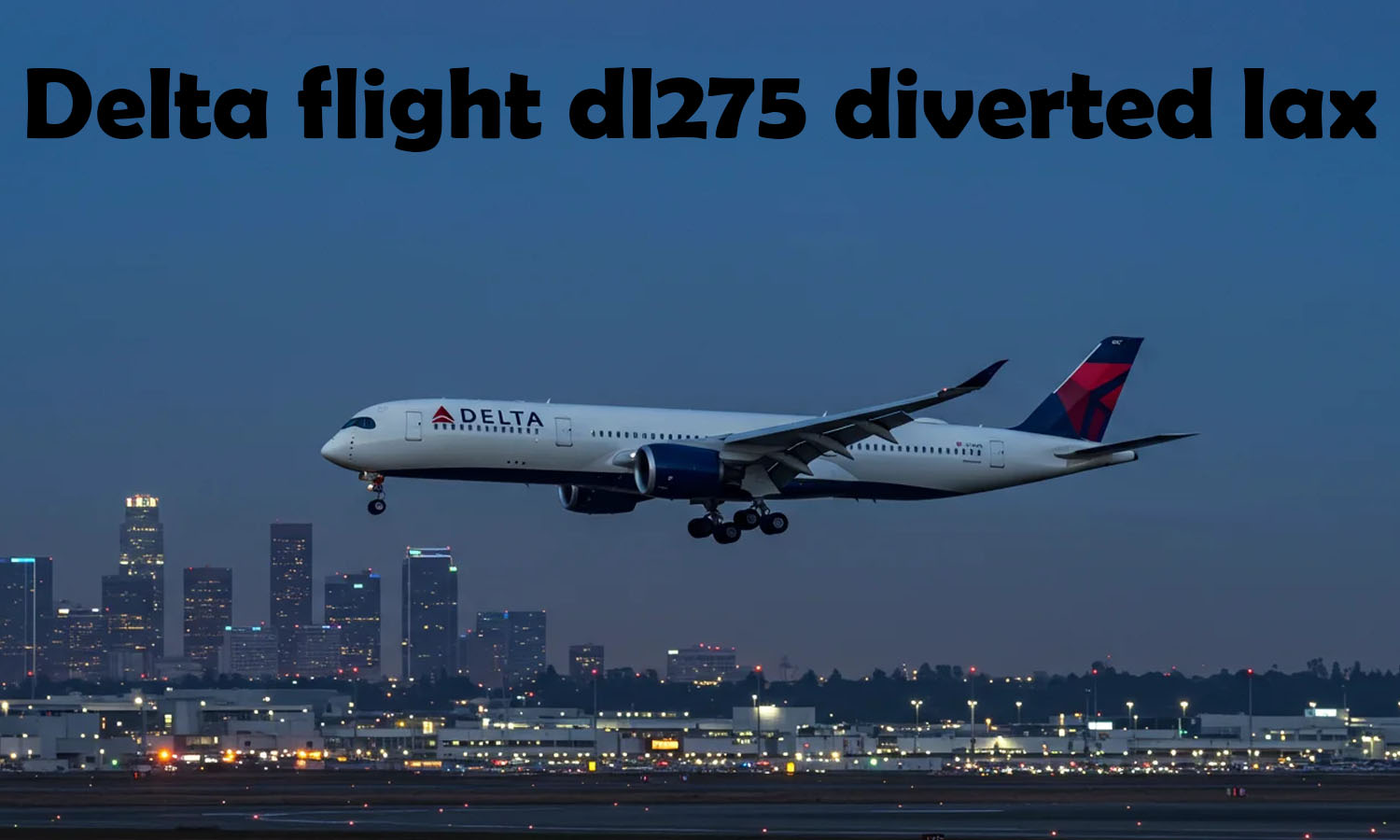News
Delta flight dl275 diverted lax: What Happened and Why It Matters

- Share
- Tweet /home/u433845138/domains/newsmm.co.uk/public_html/wp-content/plugins/mvp-social-buttons/mvp-social-buttons.php on line 71
https://newsmm.co.uk/wp-content/uploads/2025/07/bb-b-8-1000x600.jpg&description=Delta flight dl275 diverted lax: What Happened and Why It Matters', 'pinterestShare', 'width=750,height=350'); return false;" title="Pin This Post">
Imagine being thousands of feet in the air, halfway across the vast Pacific Ocean, on your way to an exciting destination like Tokyo. Suddenly, the calm hum of the engines changes, and the captain’s voice comes over the intercom, announcing an unexpected change of plans: your flight is diverting. This was the reality for passengers on Delta Flight DL275, a routine service from Detroit to Tokyo Haneda, when it made an unscheduled landing at Los Angeles International Airport (LAX). This incident, which occurred recently on May 26, 2025, sparked immediate questions about the flight, its passengers, and the complex safety protocols that govern international air travel.
The Journey Interrupted: A Closer Look at DL275’s Diversion
Delta Air Lines flight DL275 is a daily, long-haul service connecting Detroit Metropolitan Wayne County Airport (DTW) with Tokyo Haneda Airport (HND) in Japan. On this particular day, May 26, 2025, the flight was operated by an Airbus A350-900, a modern wide-body aircraft known for its efficiency and comfort on long routes. The specific aircraft involved bore the registration N508DN, a twin-jet that is approximately seven years old and part of Delta’s extensive A350 fleet.
The journey began with a slight delay, as the inbound flight (DL133 from Amsterdam Schiphol Airport) arrived late, pushing DL275’s departure time back by almost two hours. Eventually, the Airbus A350-900 lifted off from Detroit at 3:53 PM local time. For hours, the flight proceeded as planned, cruising over the North American continent and into the vast expanse of the Pacific. However, as the aircraft approached the Bering Sea, a critical issue arose.
Reports indicate that one of the aircraft’s Rolls-Royce Trent XWB engines experienced a problem with its anti-ice system. This system is crucial, especially when flying at high altitudes where temperatures can drop significantly below freezing, making ice formation on engine components a serious risk. While the exact nature and severity of the malfunction were not immediately disclosed, the flight crew, prioritizing the safety of everyone on board, made the decision to divert. Instead of continuing west towards Tokyo, the aircraft made a significant turn and headed southeast, setting a new course for Los Angeles International Airport (LAX).
The diversion added a considerable amount of flight time to the journey. The flight, which was initially scheduled for approximately 13 hours and 10 minutes to Tokyo, ended up flying for more than 12 hours and 15 minutes just to reach LAX. This meant that by the time it touched down on runway 06R at LAX in the middle of the night (01:08 AM local time on May 27, 2025), passengers had been in the air for almost as long as the entire planned trip to Tokyo. The decision to divert to LAX, despite other closer Delta hubs like Seattle, was likely a strategic one, given LAX’s status as a major Delta hub with the necessary facilities, maintenance capabilities, and support staff to handle such an unexpected arrival.

Why Diversions Happen: Understanding Aviation Safety
Flight diversions, while disruptive, are a testament to the robust safety systems and highly trained professionals within the aviation industry. They are not uncommon, and they happen for a variety of reasons, all primarily centered around ensuring the safety of passengers and crew. In the case of Delta DL275, the reported issue with the engine’s anti-ice system falls under the category of a mechanical or technical malfunction.
Here are some of the most common reasons why flights are diverted:
- Technical or Mechanical Issues: Like the anti-ice system problem on DL275, aircraft can experience a wide range of technical faults during flight. These can include issues with engines, hydraulic systems, electrical systems, pressurization, or any other critical component that might compromise the aircraft’s airworthiness or the safety of its operation. Pilots and airlines always err on the side of caution when these issues arise.
- Medical Emergencies: A passenger or crew member experiencing a severe medical emergency onboard often necessitates a diversion. Getting the individual immediate medical attention is paramount, and diverting to the nearest suitable airport with medical facilities is often the quickest way to achieve this.
- Unruly Passengers: While less common than technical or medical reasons, a passenger whose behavior poses a threat to the safety or comfort of others, or who is disruptive to the flight operations, can lead to a diversion. Airlines and law enforcement take such incidents very seriously.
- Weather Conditions: Adverse weather at the destination airport (e.g., severe storms, heavy fog, high winds) can make landing unsafe. In such cases, flights are diverted to alternate airports where weather conditions permit a safe landing.
- Air Traffic Control (ATC) Restrictions or Airport Closures: Sometimes, unexpected events like an airport closure due to an incident, runway issues, or even a sudden increase in air traffic can lead to ATC directing a flight to an alternate airport.

- Fuel Considerations: While pilots plan for sufficient fuel for the primary route and alternate airports, unforeseen circumstances like extended holding patterns due to air traffic or unexpected weather can deplete fuel reserves, necessitating a diversion to the nearest suitable airport.
In all these scenarios, the decision to divert is made by the flight crew, often in consultation with airline operations centers and air traffic control. Their primary goal is always to land the aircraft safely, and they are trained to assess the situation and choose the best course of action, which includes selecting an appropriate alternate airport that can handle the aircraft type and provide the necessary support. For a large aircraft like the A350-900, this typically means diverting to a major international airport with extensive facilities and Delta’s own operational presence.
The Passenger Experience: Dealing with the Unexpected
For the nearly 300 passengers on board Delta DL275, the diversion to LAX undoubtedly turned a planned international journey into a long and uncertain ordeal. Being diverted, especially on a trans-Pacific flight, can be a frustrating and anxiety-inducing experience. Passengers often face:
- Extended Travel Time: As seen with DL275, the diversion itself added many hours to the travel time, effectively doubling the length of the initial flight segment.
- Uncertainty and Delays: Once on the ground at the diversion airport, passengers often face delays as the airline works to assess the situation, arrange for a new aircraft, re-crew the flight, or make alternative travel arrangements. This can involve waiting for hours in the terminal, or even having to spend the night.
- Logistical Challenges: Depending on the reason for the diversion and the facilities at the alternate airport, passengers might encounter challenges with immigration and customs (especially for international flights diverted to a different country than their destination), baggage handling, and access to food and accommodations.
- Impact on Connecting Flights: For passengers with connecting flights, a diversion almost certainly means missing their onward connections, leading to further rebooking and delays.
- Discomfort and Fatigue: Long hours in an airplane, followed by an unexpected landing and subsequent waiting, can lead to significant discomfort and fatigue for travelers.
Airlines generally have established protocols for handling diverted passengers. This typically includes:
- Providing Information: Keeping passengers informed about the reason for the diversion, the expected duration of the delay, and the plans for onward travel is crucial. Clear and frequent communication helps manage expectations and reduce anxiety.
- Basic Amenities: For extended delays, airlines are usually responsible for providing food and beverages. If an overnight stay is required, they often arrange for hotel accommodations and ground transportation.
- Rebooking and Re-routing: The airline will work to rebook passengers on the next available flight to their original destination, either on their own airline or on partner airlines. In some cases, a replacement aircraft may be flown to the diversion airport to continue the journey.
- Compensation: While not always legally required for all types of diversions (e.g., weather-related), airlines may offer compensation in the form of travel vouchers, miles, or refunds, especially if the diversion was due to an issue within the airline’s control, such as a mechanical problem.
Delta Air Lines, as a major carrier, would have initiated these procedures to assist the passengers of DL275. Their goal would have been to get passengers to Tokyo as quickly and comfortably as possible, while prioritizing safety above all else.
The Bigger Picture: Air Traffic Control and Airline Response
The successful diversion of Delta DL275 to LAX highlights the intricate coordination between the flight crew, the airline’s operations center, and air traffic control (ATC). When a pilot declares an emergency or requests a diversion, ATC plays a crucial role in:
- Clearing Airspace: ATC works to clear the necessary airspace for the diverting aircraft, ensuring a safe and clear path to the alternate airport.
- Providing Guidance: Controllers provide vectors, altitude clearances, and other crucial information to guide the aircraft safely to its new destination.
- Coordinating with Airport Services: ATC alerts the ground services at the diversion airport, including emergency services (fire, medical), ground handling crews, and airline personnel, so they are prepared for the aircraft’s arrival.
Airlines, on their part, activate their operational control centers (OCCs) during such events. These centers are staffed by experts who monitor flights worldwide, manage unexpected events, and make critical decisions regarding diversions, re-routing, and passenger support. Their role includes:
- Technical Support: Engineers and maintenance specialists assess the reported issue and advise the flight crew.
- Logistics and Planning: Teams work to find alternative aircraft, secure new crew members if needed (due to duty time limits), and arrange for passenger rebooking and accommodations.
- Communication: Communicating with passengers, ground staff, and regulatory authorities.
The prompt and safe landing of DL275 at LAX demonstrates the effectiveness of these interconnected systems and the professionalism of everyone involved, from the pilots in the cockpit to the air traffic controllers on the ground.
Learning from Diversions: Enhancing Future Travel
Every flight diversion, especially one involving a significant technical issue like the engine anti-ice system on DL275, serves as a valuable learning opportunity for airlines and aviation authorities. Investigations, such as those that would follow this incident, aim to:
- Identify the Root Cause: Determine precisely why the anti-ice system malfunctioned.
- Prevent Future Occurrences: Implement corrective actions, which could include revised maintenance procedures, software updates, or even modifications to aircraft components.
- Improve Operational Responses: Refine existing protocols for handling similar situations in the future, from crew training to passenger communication.
For passengers, understanding the reasons behind diversions and the procedures airlines follow can help manage expectations and reduce stress during such unexpected events. While no one wishes for a flight diversion, knowing that these measures are in place to prioritize safety can offer some reassurance.
In conclusion, the diversion of Delta Flight DL275 to LAX was an unexpected detour for nearly 300 travelers. Caused by a technical issue with an engine’s anti-ice system, it highlighted the constant vigilance required in modern aviation. More importantly, it underscored the dedication of flight crews, the sophistication of air traffic control, and the comprehensive operational responses by airlines, all working in harmony to ensure that even when plans go awry, the safety and well-being of those in the sky remain the absolute top priority. This incident, while disruptive, ultimately reinforces the incredible safety record of air travel and the continuous efforts to make every flight as secure as possible.
10 Frequently Asked Questions (FAQs)
- What is a flight diversion? A flight diversion happens when a plane has to change its planned route and land at an airport other than its original destination. This is usually due to unexpected events that make continuing to the original destination unsafe or impossible.
- Why did Delta Flight DL275 divert to LAX? Delta Flight DL275 diverted to LAX because of a problem with the anti-ice system on one of its Rolls-Royce Trent XWB engines. This system is very important for preventing ice from building up on the engine, especially at high altitudes.
- When did this diversion happen? The diversion of Delta Flight DL275 to LAX happened on May 26, 2025, with the aircraft landing in Los Angeles on May 27, 2025.
- What kind of plane was involved in the diversion? The aircraft involved was a modern Airbus A350-900, which is a wide-body, twin-engine jetliner often used for long-haul international flights. The specific plane had the registration N508DN.
- How long did the flight last before it landed in LAX? The flight from Detroit to Los Angeles, after the diversion, took about 12 hours and 15 minutes. This was almost as long as the entire scheduled flight to Tokyo.
- What happens to passengers when a flight is diverted? When a flight is diverted, airlines work to take care of the passengers. This often includes giving them updates, providing food and drinks, arranging hotel stays if needed, and rebooking them on other flights to their final destination.
- Is it common for flights to be diverted for mechanical issues? While not an everyday occurrence, flight diversions due to mechanical issues do happen. They are a sign that the airline and flight crew are prioritizing safety and taking immediate action when a problem arises with the aircraft.
- Why was LAX chosen as the diversion airport instead of somewhere closer? LAX was likely chosen because it is a major Delta Air Lines hub. This means it has the necessary facilities, maintenance teams, spare parts, and support staff to handle a large aircraft like the A350-900 and assist its passengers effectively.
- Who makes the decision to divert a flight? The final decision to divert a flight is made by the flight crew, specifically the captain. They work closely with the airline’s operations center and air traffic control to decide the best course of action for safety.
- What is the significance of this diversion for aviation safety? This diversion, like all others, shows how important strict safety protocols are in aviation. It also highlights the quick thinking and expertise of flight crews and ground support teams who work together to manage unexpected situations and ensure everyone on board lands safely. Each incident provides valuable lessons that help further improve airline operations and aircraft design.
Click for more amazing info. News MM

-

 Celebrity8 months ago
Celebrity8 months agoIndia Rose Brittenham: All You Need to Know About Heather Thomas’ Daughter
-

 Celebrity8 months ago
Celebrity8 months agoMargot Rooker: All You Need to Know About Michael Rooker’s Wife
-

 Celebrity8 months ago
Celebrity8 months agoNadia Farmiga? All You Need to Know About Taissa Farmiga’s Sister
-

 Celebrity8 months ago
Celebrity8 months agoRobert Noah? All You Need to Know About Trevor Noah’s Father
-

 Celebrity7 months ago
Celebrity7 months agoJackie Witte? All You Need to Know About Paul Newman’s First Wife
-

 Celebrity8 months ago
Celebrity8 months agoCheryl Pistono? All You Need to Know About Kareem Abdul-Jabbar’s Ex-Girlfriend
-

 Celebrity8 months ago
Celebrity8 months agoAbigail S. Koppel? All You Need to Know About Leslie Wexner’s Wife
-

 Celebrity7 months ago
Celebrity7 months agoWho is the Father of Jay-Z? Biography of Adnis Reeves












